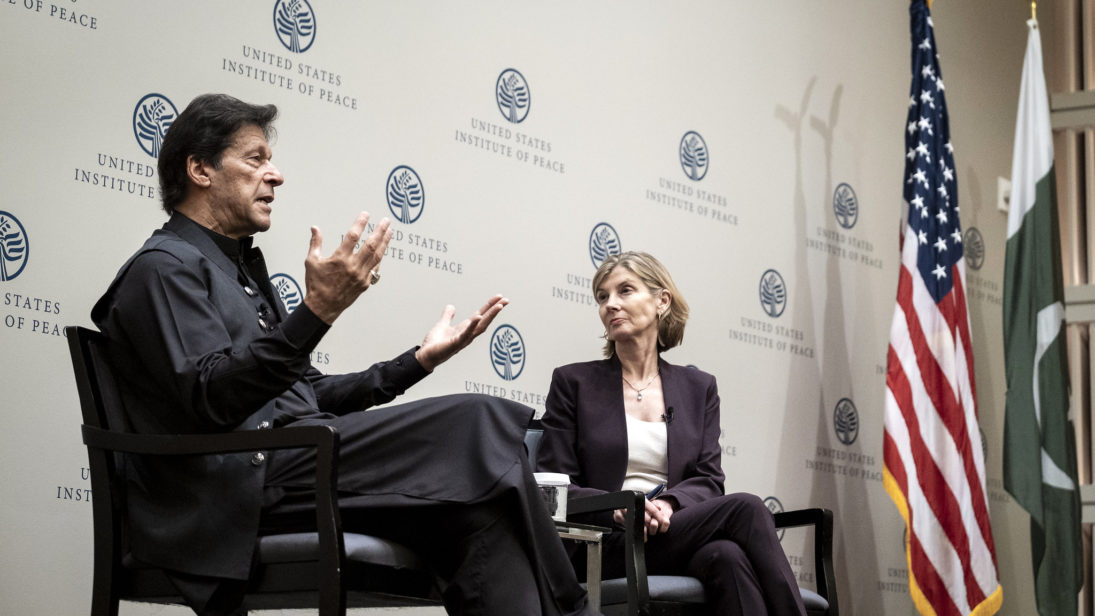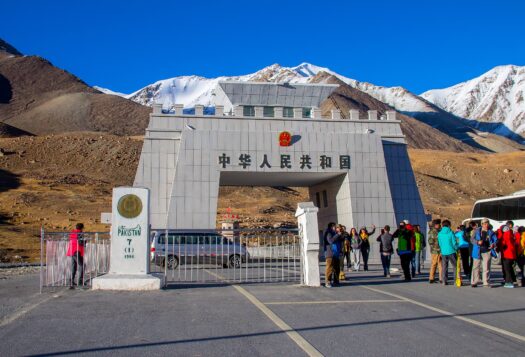
In his recent visit to the United States, Pakistan’s Foreign Minister Shah Mahmood Qureshi met with Pakistani-American entrepreneurs in New York to encourage foreign investment in Pakistan. Over the past few months, numerous high-level officials in Pakistan’s government, including National Security Advisor Moeed Yusuf and Chief of Army Staff General Qamar Javed Bajwa, have pushed for a recalibration of U.S.-Pakistan relations away from geostrategy and geopolitics—the influence of geographic dynamics on international power dynamics—and towards geoeconomics—the influence of global economic trends on foreign relations. The Pakistani state envisioned its geoeconomic turn in the context of decreasing domestic terrorism and the U.S. intention to withdraw from Afghanistan. Restructuring U.S.-Pakistan relations along economic lines could help improve Pakistan’s reputation as a terrorism-ridden security state and enhance prospects of domestic and regional peace and stability. While Pakistan pushes for an economics-driven foreign policy at the diplomatic level, it can only realize this vision after undertaking significant domestic economic reforms and rebranding itself as an open international market.
Pakistan can only realize its vision for an economics-driven foreign policy after undertaking significant domestic economic reforms and rebranding itself as an open international market.
Politically Motivated vs. Profit-Motivated Investment
Before diving into how Pakistan could improve its investment climate for international investors, it is essential to differentiate between investments from China—especially through the China-Pakistan Economic Corridor (CPEC)—and investments from the United States. First and foremost, CPEC was a government-to-government agreement to develop infrastructure, roads, and energy in Pakistan. State-led Chinese investments are not driven exclusively by economic motivations. Political and security relations have at least as strong an influence. Specifically, in order to bolster its long-term strategic goals, China is often willing to accept near-term unfavorable investments for long-term influence.
U.S. investments are typically economically (profit) motivated, and U.S. companies independently choose to invest in attractive economies. Exceptions to this rule are USAID initiatives that have contributed significantly to economic development but have been widely criticized for internal mismanagement and lack of sustainability required for long-term projects. The U.S. government cannot itself directly facilitate private sector investments. The U.S. government can, however, reconsider its narrative of Pakistan’s security conditions and CPEC investments and nudge private investors towards Pakistani projects through groups such as the U.S.-Pakistan Business Council. Yet the onus remains on Pakistan to improve its investment climate and impress profit-motivated investors in the United States. This would require Pakistan immediately address domestic barriers, including bureaucratic inefficiencies, restrictive laws, and inconsistency in economic policies.
The Uncertain Economy
Pakistan’s post-pandemic economy has shown signs of recovery, largely due to the conditions imposed by the International Monetary Fund (IMF) program. Pakistan’s foreign reserves have nearly doubled from USD $7.2 billion in May 2018 to USD $16 billion in May 2021. The State Bank of Pakistan has estimated the GDP growth rate to rise to 3.94 percent for fiscal year (FY) 21, and the government of Pakistan set the GDP growth rate target to 4.8 percent for FY22.
Although Pakistan’s 28 spot jump in the World Bank’s Doing Business 2020 report—from 136 to 108—is commendable, the country lags behind regional neighbors India, Nepal, and Sri Lanka. Foreign direct investment (FDI) inflows have also dropped by approximately 35 percent in the first three quarters of FY 2021. Given the global pandemic, these statistics cannot be entirely attributed to the Pakistani government’s policies. However, spurts of growth followed by economic crises remains a troubling pattern for the country’s economy. Pakistan’s economic strategy must focus on investments that are sustainable and upheld with consistent economic policies.
First, Pakistan needs to address inconsistencies in its economic approaches from one government to another and avoid internal shifts and frequent reshuffling of cabinets. Over the course of Imran Khan’s three-year tenure, four different officials have held the position of finance minister: Asad Umar, Abdul Hafeez Sheikh, Hammad Azhar, and now Shaukat Tareen. Frequent finance minister overturn illustrates how the government’s economic agenda has failed, hurting investor confidence. Rapidly fluctuating and unpredictable policies slash investor confidence, making individuals hesitant to invest large amounts capital and maintain investments for more than a couple of years. Such internal inconsistency and bureaucratic red tape promote rent-seeking behavior —investing for a short period of time to gain maximum profit without creating long-term benefits and wealth for the economy—which further inhibits growth and ambition.
Rapidly fluctuating and unpredictable policies slash investor confidence, making individuals hesitant to invest large amounts capital and maintain investments for more than a couple of years.
Investors have also identified that inconsistent tax regulations from provincial and federal authorities and frequent delays due to incompetent bureaucratic institutions have made it difficult for them to gauge the profitability of investments. For example, Special Economic Zones—areas intended for rapid economic growth through foreign investment by offering tax and business incentives—made investors exempted from all income taxes for ten years. However, the Pakistani government began charging a minimum of 1.5 percent turnover tax—an indirect tax on the estimated value of a good—in lieu of income tax. The Pakistan Business Council has described these taxes as “extremely high and unrealistic.” It is also difficult to expect investors to establish manufacturing plants when 26 percent of Pakistan does not have access to grid electricity and load-shedding remains commonplace. Electricity shortage is at the core of Pakistan’s investment dilemma, as is illustrated by the damaging delays to the Renault Motors car manufacturing plant in Karachi. Although China’s investments have helped with some power grid issues, Pakistan’s power sector makes the highest losses in South Asia, and the cost of power is also more expensive than regional countries.
The complicated regulatory system in Pakistan further deters foreign investment. Foreign businesses must address often inconsistent laws and policies from both provincial and federal regulatory authorities. A judicial system that expects foreign investors to file in regular courts, instead of fast-track courts for expedited conflict resolution, also complicates matters. The Reko Diq Arbitration Case is a model example of inconsistent regulatory policy. In 1993 BHP Minerals signed an agreement with the Balochistan government to mine copper and gold in the Reko Diq mine of Balochistan. In 2006, this company was replaced by an Australian joint venture called the Tethyan Copper Company (TCC), which would acquire the terms of prior agreements. Although the Balochistan High Court validated the agreement in 2007, the Supreme Court of Pakistan declared the agreement void in 2013, and a long-drawn and expensive legal battle for Pakistan ensued. Similarly, when Walter Power International Limited (WPI), based in Oklahoma City, sent power generation equipment to Pakistan in 2009 to help alleviate the country’s power shortages, the Supreme Court intervened and nullified the contract due to widespread corruption. Even after the National Accountability Bureau in Pakistan settled the dispute with WPI, the government of Pakistan refused to re-export the equipment back to the United States. The Reko Diq and WPI cases illustrate the deep-rooted tensions involved in Pakistan’s judicial dealings with foreign investors. Such public court interventions in private investment matters cannot guarantee security and policy certainty for a 20- or 25-year long-term investment.
Although Pakistan’s internal security situation has improved considerably, its place on the FATF gray list, signaling the threat of money-laundering and terror-financing, represents an additional layer of risk for international investors.
The Financial Action Task Force (FATF) is another major barrier to Pakistan’s geoeconomic pivot ambitions. Although Pakistan’s internal security situation has improved considerably, its place on the FATF gray list, signaling the threat of money-laundering and terror-financing, represents an additional layer of risk for international investors. Although the reputational risks of the gray list aren’t nearly as serious as those of the black list, increased risk perception from the gray-listing threatens to keep investors out of the country. Deloitte’s exit from Pakistan in November 2020 made Pakistan the only country amongst the top ten most populated countries in the world that does not have all Big Four accounting firms—Deloitte, Ernst and Young (EY), Pricewaterhouse Coopers (PwC), and KPMG). This signaled the diminishing of Pakistan’s international reputation and increases doubt about the credibility of Pakistan’s investment climate. Whether Deloitte’s exit was related to Pakistan’s alleged terror-financing or not, it illustrates how the security risk remains high for international investors.

Setting up a Stronger Investment Environment
Pakistan has the ability and capacity to realize its geoeconomic objectives through sustainable domestic reform. This could include setting up fast-track courts to arbitrate international investment cases, establishing a central regulatory authority, harmonizing tax codes, and fighting terror-financing and money-laundering. The government should invest in research and development to create an innovative and stimulating investment climate through increasing involvement of the diaspora in investment-related policy-making decisions, encouraging creativity beyond the confines of religious laws, and reducing licensing fees amongst other economic measures to attract payment-transfer facilities, such as PayPal, support direct business-to-business contact. With help from its diaspora community, Pakistan can also recalibrate its marketing strategy to capture the imagination of international investors. Now that Chinese investors are setting up manufacturing facilities for the production of a variety of products, including beer and garments, the next step is to build momentum and attract non-Chinese investors.
The onus of realizing this geoeconomic shift does not only fall exclusively on the Pakistani government. Although the former Pakistan Muslim League-N (PML-N) government explicitly prioritized Chinese investments, the current Pakistan Tehreek-e-Insaaf (PTI) government has consistently sought to develop trade relations with the United States and China and emphasized that relations with China are not a “zero-sum game.” However, the U.S. government’s China-hesitant rhetoric has, to an extent, heightened caution amongst U.S. investors from exploring the Pakistani market. U.S. diplomat and former U.S. Ambassador to Jordan Alice Wells’ strong criticism of CPEC in 2019 marked a shift in U.S. policy towards implicitly including Pakistan as a field for its larger economic great power competition with China. Even recently, U.S. government officials have criticized the China-Pakistan Economic Corridor (CPEC) for its lack of transparency and debt-trap diplomacy features. The U.S. business community, nudged by the U.S. government, is likely to view CPEC with suspicion. Yet it is in its own interest to tap the potential of fast-developing CPEC-built Special Economic Zones (SEZs) and road infrastructure in the resource-rich country with a young workforce and burgeoning middle class. Islamabad, in return, should be more transparent with the Pakistani public about the terms of CPEC loans and widen CPEC-related consultations to involve all stakeholders. Stepping away from exaggerated “China camp” rhetoric could significantly help reform U.S.-Pakistan relations.
Entrenched obstacles including the long-standing problem of “elite capture” and rigid bureaucratic practices will be tough to reform. Pakistan also faces geopolitical constraints as it competes with faster-growing economies Vietnam and India for U.S. investment. Yet recent economic policies, including efforts to temporarily abolish withholding tax over usage of credit cards to promote the digital economy, suggest a positive trend in Pakistan’s investment future. Similar efforts to cut bureaucratic red tape and build economic reliability will enable Pakistan to shift from being a U.S. security partner to an economic investment opportunity.
***
Image 1: USIP via Flickr
Image 2: Imagestock via Getty Images


